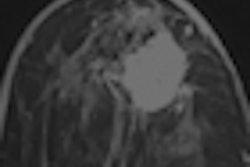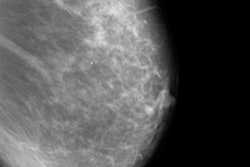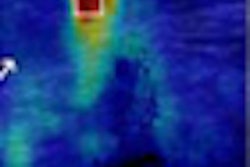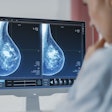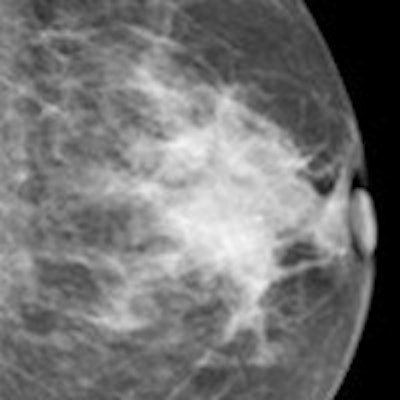
A separate full-field digital mammography (FFDM) study may not be necessary when performing contrast-enhanced digital mammography (CEDM) exams, as the low-energy image may be sufficient for interpretation, according to a new European Journal of Radiology study. This ultimately means a reduction in patient dose.
CEDM uses low-energy (26-30 kVp) and high-energy (45-49 kVp) exposures to produce a subtracted contrast image that highlights sites of contrast enhancement in the breast, according to lead author Dr. Mark Francescone from Columbia University Medical Center in New York. The technique has shown promise for a number of applications, such as screening high-risk women, imaging women with dense breast tissue, and problem-solving in difficult cases.
"CEDM is reportedly as sensitive as MRI and more sensitive than standard digital mammography in identifying breasts containing known cancers, and is more specific than MRI in depicting additional foci of ipsilateral disease," he and his colleagues wrote (EJR, August 2014, Vol. 83:8, pp. 1350-1355). "When used as an adjunct to mammography, CEDM significantly improves diagnostic accuracy compared to noncontrast mammography. It is clear that utilizing iodinated contrast with mammography facilitates breast lesion visualization."
But standard clinical practice calls for acquiring a conventional FFDM exam whenever CEDM is performed. This requires additional time and expense, and exposes patients to additional radiation dose. What if information in the CEDM study could provide the same information as that of the FFDM exam?
Indeed, intravenous iodinated contrast is the only difference between the low-energy portion of the CEDM study and a standard FFDM -- even the system is the same (Senographe, GE Healthcare). In addition, the low-energy exposure is below the k-edge of iodine (33 keV) and, therefore, the photoelectric effect is minimized, meaning the low-energy exposure should be blind to iodine.
"Thus, we hypothesized that the presence of iodine in the breast should have no effect on the appearance of the low-energy CEDM image, and that this image should not differ from a standard digital mammogram," they wrote. "Currently, patients undergoing CEDM are required to have standard mammography in addition to the dual-energy examination. However, if the low-energy CEDM image obtained after iodine injection truly is the same as a standard digital mammogram, then these low-energy images could be used as the standard mammogram, thereby reducing radiation dose."
Francescone and his colleagues compared low-energy CEDM images of 170 breasts in 88 women undergoing evaluation for elevated risk or newly diagnosed breast cancer with standard digital mammograms performed within six months. Technical parameters such as posterior nipple line distance, compression thickness, and compression force on the mediolateral oblique (MLO) projection were compared. Mammographic findings were compared qualitatively and quantitatively.
No statistical difference was found in technical parameters such as compression thickness, posterior nipple line distance, or compression force. Neither was there a difference in the measured size of mammographic findings. In terms of grouped calcifications, low-energy contrast images had a mean size/extent of 2.1 cm, and standard FFDM had a mean size/extent of 2.2 cm with equal visibility on both modalities. Masses had a mean size of 1.8 cm in both groups.
Posterior nipple line distance and compression are benchmarks for the technical adequacy of a mammogram, so this study demonstrated there was no statistically significant difference between the low-energy CEDM images and the standard digital mammograms, according to the researchers.
"The prior administration of iodine to the patient before she is placed in compression and the presence of iodine in the breast during compression do not affect these technical mammographic benchmarks," they wrote. "This indicates that technical factors involved in obtaining quality mammography are the same in contrast -- and noncontrast -- mammograms."
The researchers also point out the average glandular dose for low-energy CEDM (mean 2.00 mGy) did not differ substantially from the standard mammogram (1.72 mGy).
"The larger overall glandular dose delivered by the dual-energy CEDM examination only underscores the benefit of the low-energy image serving as the standard mammogram, thereby eliminating extra unnecessary radiation," they wrote.
In addition, previous reports have shown that adding CEDM to FFDM detects more malignant lesions; adding CEDM to MRI detects more histologically proven cancers than conventional mammography alone; CEDM depicts enhancement on a background of dense tissue making detecting cancers in dense breasts easier; and its specificity for identifying additional areas of ipsilateral disease is greater than MRI.
"As these potential roles for CEDM continue to be investigated and validated, the ability of the low-energy images to serve as a built-in standard mammogram will only make this modality more attractive for routine use in clinical breast imaging," the researchers concluded.




